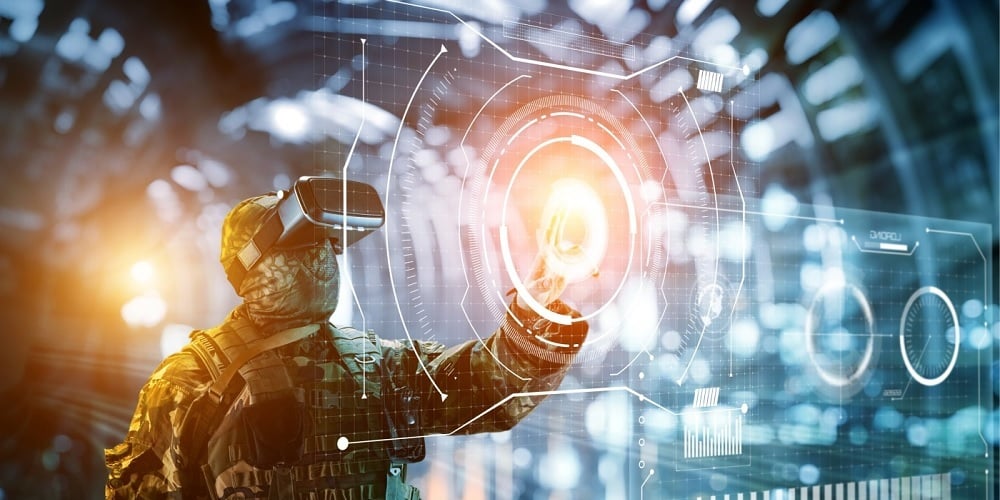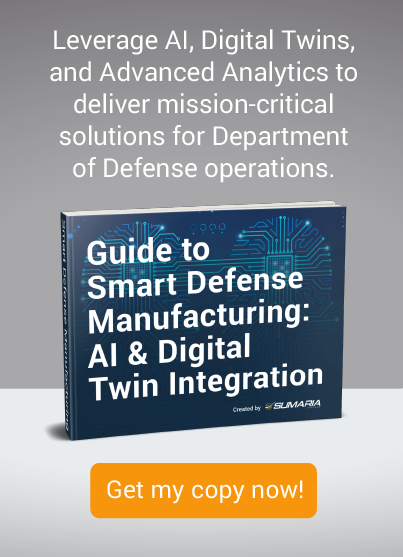
7 Ways That AI-Powered Digital Twins Are Shaping the Future of Defense
Modern defense programs are under constant pressure. Programs face rising complexity, shrinking budgets, fragile supply chains, and the unrelenting need for mission readiness. Traditional production methods are often too reactive, slow, and costly. A single disruption, whether from a supplier issue or an equipment breakdown, can ripple across projects and shut down workflow.
AI-powered digital twins offer a path forward.
By combining AI with dynamic digital models and machine learning, defense programs can shift from reactive to predictive strategies. Instead of waiting for problems to occur, these intelligent systems simulate, forecast, and optimize in real time, recommending alternatives and solving minor concerns before they escalate into major problems.
This shift has the full backing of the government: DoD Instruction 5000.97 makes digital engineering a standard practice across acquisition and sustainment, embedding virtual-first approaches into lifecycle management.
Seven Ways That AI-Powered Digital Twins Are Transforming Defense Programs
1. Virtual Prototyping and Early Failure Prediction
Physical prototyping is expensive and slow. Digital twins empower engineers to run virtual stress tests, environmental simulations, and what-if scenario analyses before investing the time and money in creating physical models. This helps catch design flaws earlier.
For example, digital twins in radar system development enable the simulation of various electromagnetic environments to expose potential vulnerabilities before designs are complete, thereby shortening iteration cycles with a more efficient and effective model.
By validating tradeoffs virtually, manufacturers can avoid multiple rounds of costly prototyping. Time-to-first-article shrinks when flaws are discovered and fixed in the digital domain. For military programs where speed and reliability are non-negotiable, early virtual validation is a decisive advantage.
2. Real-Time Production Optimization
On the production floor, precision and throughput often determine mission success. The integration of real-time sensors, PLCs, and IoT data with twin models enables the dynamic adjustment of manufacturing lines. While the data shows a live snapshot of manufacturing operations, AI analyzes the inputs to detect inefficiencies and adapt instantly.
Systems can predict potential bottlenecks and examine tool wear or throughput to suggest more optimal workflows. An example is dynamic adjustments during manufacturing test beds in aerospace parts factories, where precision and flexibility are crucial. AI-powered digital twins can monitor tooling and throughput, automatically redistributing workloads or fine-tuning machining parameters. This creates factories that maintain accuracy and consistency while minimizing waste and downtime. The result is optimized production that doesn’t compromise the demanding standards of military-grade systems.
3. Predictive Maintenance and Lifecycle Forecasting
Digital twins provide ongoing support even after machining is complete, continuing to generate value by ingesting telemetry and sensor data from deployed systems, feeding predictive models that forecast failures, and informing maintenance schedules.
Instead of waiting for equipment to fail, predictive insights schedule maintenance at just the right time. Advanced digital twins serve as in-memory software models that continuously ingest streams of operational data, with AI spotting subtle issues that can be easily missed in traditional monitoring. The payoff is longer equipment lifespans, reduced sustainment costs, and improved mission readiness.
In terms of efficiency gains, studies show that this approach can reduce downtime by 30% and maintenance costs by up to 20%.
4. Supply Chain “What-If” Simulations and Risk Mitigation
Supply chains today are incredibly complex and vulnerable, especially since there is a limited number of suppliers for certain components, and project knowledge may be sensitive. If a supplier shuts down or a logistics route is delayed, the digital twin can model alternative sourcing, buffer inventories, or adjusted production schedules.
The Defense Logistics Agency is exploring digital twin use to predict supply disruptions and optimize daily operations. A two-year test run showed significant improvements and is now in full-scale deployment.
By testing options virtually, decision-makers can avoid costly surprises and select strategies to maintain resilience under pressure.
5. Human- and AI-Powered Digital Twins for Quality Assurance and Worker Augmentation
Beyond machines, human operators can be augmented with digital twins to detect errors in assembly, interface misalignments, or quality deviations. For example, researchers at Southern Methodist University are building human digital twin systems that use cameras, AI, and VR to detect misalignments, incorrect assembly, or deviations from quality standards. By simulating human-machine interactions, AI and twin models help reduce assembly errors, improve ergonomics, and reduce rework in the military manufacturing process, ensuring that every component meets exacting requirements.
6. Edge and Tactical Manufacturing Through Networked Systems
The battlefield is dynamic, and manufacturing must sometimes adapt on the fly. Digital twins enable the synchronization between deployed assets and production nodes, extending manufacturing intelligence to the edge. This creates tight synchronization between deployed assets and production nodes.
A good example of this in practice is managing and improving network systems and communication. Digital twins can optimize these complex production systems even when under extreme stress.
Systems can also adapt to battlefield information or constraints, or reconfigure supply nodes, enhancing tactical adaptability. For example, forward-deployed production or repair units could adjust operations based on streaming data from the field. This means supply nodes or manufacturing cells can reconfigure in response to evolving operational demands.
By linking production systems with real-time battlefield data, manufacturers create a closed feedback loop between operations and sustainment.
7. Real-Time Digital Twins in Battlefield Intelligence
The battlefield is among the most complex and unpredictable environments that military leaders face. Information arrives in drips and is often fragmented. Data might come from satellites, drones, ground sensors, human intel, or communications networks. Commanders must assimilate all this information and are often required to make decisions under extreme time pressure. Historically, much of this data was siloed, analyzed after the fact, or simply too overwhelming to interpret in real time.
AI-powered digital twins are changing things.
With a live, synchronized digital model of the battlefield, the systems can integrate streams of multi-domain data into a single, dynamic environment. This enables leaders to see the current picture for better situational awareness and test potential actions virtually before committing to a specific strategy.
Instead of receiving static reports, commanders can get deep insight by viewing a twin of the battlespace that automatically updates as conditions shift. For example, satellite imagery can be analyzed by AI to detect hidden movements, while drone feeds and ground sensors provide additional context.
AI-powered digital twins also become predictive tools, testing how different troop movements, air support allocations, or resupply routes might play out. By simulating multiple courses of action in seconds, digital twins help leaders anticipate adversary moves and choose the path with the highest likelihood of success.
Here’s how this plays out in the real world, with a logistics convoy operating in a contested region: The digital twin ingests terrain data, enemy movement reports, and drone footage, flagging potential points where ambushes might occur. Commanders then simulate several different convoy routes through the twin, each with calculated probabilities of delay or attack to provide the best possible solution.
Modern warfare is also multi-domain, encompassing land, air, sea, space, and cyber. Digital twins provide a common operating picture by blending inputs across all of these environments into a single, coherent model.
From Reactive to Predictive Military Manufacturing
The military manufacturing industry is no longer defined solely by physical production. It is increasingly about building intelligent, adaptive systems that can anticipate problems, optimize processes, and support readiness across the lifecycle.
AI-powered digital twins are reshaping every stage of defense programs.
Digital twins and AI bring real-time foresight and control into defense manufacturing. Whether building new systems or sustaining legacy platforms, these technologies empower DoD leaders to reduce cost, mitigate risk, and ensure production resilience at scale. Contact us for help with the strategic integration of advanced technologies and methods to streamline and optimize the development, maintenance, and operation of systems and infrastructures.

